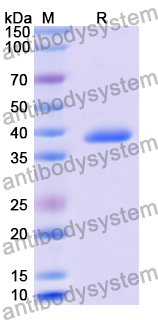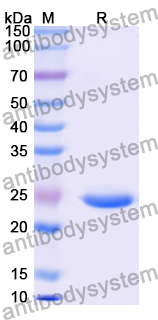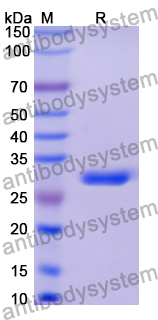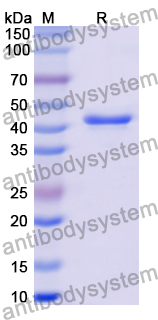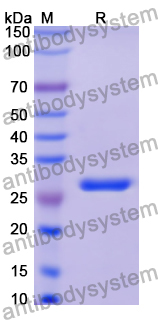Catalog No.
YHC93801
Expression system
E. coli
Species
Homo sapiens (Human)
Protein length
Lys271-Tyr364
Predicted molecular weight
39.14 kDa
Nature
Recombinant
Endotoxin level
Please contact with the lab for this information.
Purity
>90% as determined by SDS-PAGE.
Accession
P12524
Applications
ELISA, Immunogen, SDS-PAGE, WB, Bioactivity testing in progress
Form
Lyophilized
Storage buffer
Lyophilized from a solution in PBS pH 7.4, 0.02% NLS, 1mM EDTA, 4% Trehalose, 1% Mannitol.
Reconstitution
Reconstitute in sterile water for a stock solution. A copy of datasheet will be provided with the products, please refer to it for details.
Shipping
In general, proteins are provided as lyophilized powder/frozen liquid. They are shipped out with dry ice/blue ice unless customers require otherwise.
Stability and Storage
Use a manual defrost freezer and avoid repeated freeze thaw cycles. Store at 2 to 8°C for frequent use. Store at -20 to -80°C for twelve months from the date of receipt.
Alternative Names
Protein L-Myc, Class E basic helix-loop-helix protein 38, bHLHe38, Protein L-Myc-1, V-myc myelocytomatosis viral oncogene homolog, MYCL, BHLHE38, LMYC, MYCL1
Comparative study on the mutation spectrum of L-MYC and C-MYC genes of blood cfDNA in patients with ovarian cancer and healthy females., PMID:37827180
MYCL promotes the progression of triple‑negative breast cancer by activating the JAK/STAT3 pathway., PMID:36177900
MYCL promotes iPSC-like colony formation via MYC Box 0 and 2 domains., PMID:34930932
MYCL1 Amplification and Expression of L-Myc and c-Myc in Surgically Resected Small-Cell Lung Carcinoma., PMID:34257619
Longitudinal CTCs gene expression analysis on metastatic castration-resistant prostate cancer patients treated with docetaxel reveals new potential prognosis markers., PMID:33635497
MYC, MYCL, and MYCN as therapeutic targets in lung cancer., PMID:32003251
Targeted silencing of MYCL1 by RNA interference inhibits migration and invasion of MGC-803 gastric cancer cells., PMID:31025404
A case of molecularly profiled extraneural medulloblastoma metastases in a child., PMID:29343221
Integration-free induced pluripotent stem cells derived from a patient with autosomal recessive Alport syndrome (ARAS)., PMID:29246570
Using low-risk factors to generate non-integrated human induced pluripotent stem cells from urine-derived cells., PMID:29096702
Merkel cell polyomavirus recruits MYCL to the EP400 complex to promote oncogenesis., PMID:29028833
Functional Odontoblastic-Like Cells Derived from Human iPSCs., PMID:28898112
MYCL is a target of a BET bromodomain inhibitor, JQ1, on growth suppression efficacy in small cell lung cancer cells., PMID:27764802
Screening of Human cDNA Library Reveals Two differentiation-Related Genes, HHEX and HLX, as Promoters of Early Phase Reprogramming toward Pluripotency., PMID:27335261
Antimyeloma activity of bromodomain inhibitors on the human myeloma cell line U266 by downregulation of MYCL., PMID:27276402
Transcriptional Reactivation of OTX2, RX1 and SIX3 during Reprogramming Contributes to the Generation of RPE Cells from Human iPSCs., PMID:27019633
Generation of Directly Converted Human Osteoblasts That Are Free of Exogenous Gene and Xenogenic Protein., PMID:26990860
Hepatocellular Carcinoma in Noncirrhotic Liver with Glycogenotic Foci: Basic Science Meets Genomic Medicine., PMID:26676821
Comparison of the Efficiency of Viral Transduction and Episomal Transfection in Human Fibroblast Reprogramming., PMID:26593412
Spatial genomic heterogeneity within localized, multifocal prostate cancer., PMID:26005866
Myc proteins in cell biology and pathology., PMID:25534969
Expression and prognostic value of Mycl1 in gastric cancer., PMID:25528583
Antisense downregulation of N-myc1 in woodchuck hepatoma cells reverses the malignant phenotype., PMID:9499076
The human L-myc gene encodes multiple nuclear phosphoproteins from alternatively processed mRNAs., PMID:3054516

